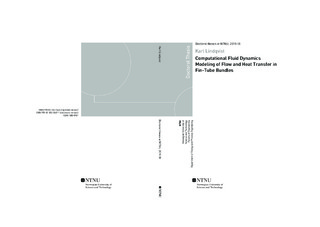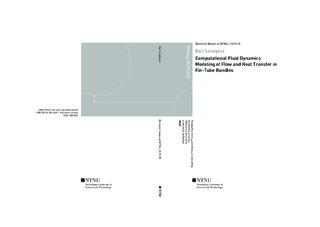| dc.contributor.advisor | Næss, Erling | |
| dc.contributor.advisor | Skaugen, Geir | |
| dc.contributor.author | Lindqvist, Karl | |
| dc.date.accessioned | 2019-02-04T10:03:21Z | |
| dc.date.available | 2019-02-04T10:03:21Z | |
| dc.date.issued | 2019 | |
| dc.identifier.isbn | 978-82-326-3647-1 | |
| dc.identifier.issn | 1503-8181 | |
| dc.identifier.uri | http://hdl.handle.net/11250/2583704 | |
| dc.description.abstract | Steam bottoming cycles, powered by gas turbine exhaust heat, are considered for offshore applications as a means of increasing the energy efficiency of power supply and reducing CO2 emissions from oil and gas production. Strict requirements on volume and weight of the steam generator means that unconventional heat exchanger designs must be considered. This calls for an extension of the validity range of existing thermal-hydraulic correlations for fin-tube bundles (the predominant heat exchanger type in this application) so that designs can be optimized for weight. The aim of the present work is therefore to develop and validate a computational fluid dynamics model of heat transfer and pressure drop in solidand serrated-fin tube bundles, and use it to expand the region of geometric parameters for which the thermal-hydraulic performance of finned tube bundles is known.
Firstly, a numerical model (grid generation, domain selection, turbulence modeling and solution method) is established and validated against experimental data for four different fin tube geometries, two with plain fins and two with serrated fins. This study is the first in open literature to simultaneously address grid convergence of the variables of engineering interest and comparison with experimental data of the same variables (and not just correlations). Predicted heat transfer and pressure drop data are within, or very close to, the experimental uncertainty for all four cases, with maximum root mean square errors of 13:8% and 14:4% respectively. It is therefore considered acceptable to use the numerical method in lieu of experimental measurement to produce data for correlation development.
The numerical model is coupled to an iterative adaptive sampling method, and combined with experimental data from open literature, to produce improved correlation for heat transfer and pressure drop with maximum impact per added data point. The root mean square errors (RMSE) of the developed correlations are reduced from 28% and 33% to 15% and 25% for pressure drop and heat transfer, respectively, compared to regression on experimental data only. The correlations are demonstrated to produce a different geometric configuration compared to a reference correlation set, when applied to a test case for weight minimization.
Fin efficiency prediction has received particular attention in this work due to its importance for design, and the relative ease at which it can be computed from first principles in a numerical simulation. The theoretical fin efficiency model is evaluated, along with proposed corrections to account for uneven distribution of the heat transfer coefficient. Correction equations are shown to be in significant error for a tall plain fin geometry. Further investigations reveals two main parameters that influence the accuracy of the theoretical fin efficiency model in extreme cases: The per-row thermal effectiveness and flow bypassing the aperture between the fins.
Parameter studies show that the direction of heat flow (gas heating or gas cooling) and the fin type (annular or helically wound) can be quite important for thermal-hydraulic performance. Specifically, pressure drop can be 25% higher for spiral fin-tubes under gas heating conditions than for equivalent annular fintubes under gas cooling conditions, which is not considered by most correlations.
The upstream turbulence level, on the other hand, is of negligible importance. The effect of the number of streamwise tube rows is significant for shallow tube bundles, but is well modeled by some existing correlations.
Finally, the numerical model is extended to the time domain and used to predict vortex shedding in a compact tube bundle. The work demonstrates that vortex suppression does not occur even if fins are added to the tubes, and that the vortex shedding frequency and amplitude is well described by equations developed for bare tube bundles, when an effective diameter is used to account for the fins. | nb_NO |
| dc.language.iso | eng | nb_NO |
| dc.publisher | NTNU | nb_NO |
| dc.relation.ispartofseries | Doctoral theses at NTNU;2019:18 | |
| dc.relation.haspart | Paper 1: Lindqvist, Karl Erik Artur; Næss, Erling. A validated CFD model of plain and serrated fin-tube bundles. Applied Thermal Engineering 2018 ;Volum 143. s. 72-79
https://doi.org/10.1016/j.applthermaleng.2018.07.060 | nb_NO |
| dc.relation.haspart | Paper 2:
Lindqvist, Karl; Næss, Erling.
On correction factors in thermal-hydraulic correlations for compact fin-tube bundles | nb_NO |
| dc.relation.haspart | Paper 3: Lindqvist, Karl Erik Artur; Wilson, Zachary; Næss, Erling; Sahinidis, Nikolaos V.. A Machine Learning Approach to Correlation Development Applied to Fin-Tube Bundle Heat Exchangers. Energies 2018 ;Volum 11.(12)
https://doi.org/10.3390/en11123450
- This article is an open access article distributed under the terms and conditions of the Creative Commons Attribution (CC BY) | nb_NO |
| dc.relation.haspart | Paper 4:
Lindqvist, Karl; Næss, Erling.
Numerical modeling of vortex shedding in helically wound finned tube bundles in cross flow | nb_NO |
| dc.title | Computational Fluid Dynamics Modeling of Flow and Heat Transfer i Fin-Tube Bundles | nb_NO |
| dc.type | Doctoral thesis | nb_NO |
| dc.subject.nsi | VDP::Technology: 500::Environmental engineering: 610 | nb_NO |

